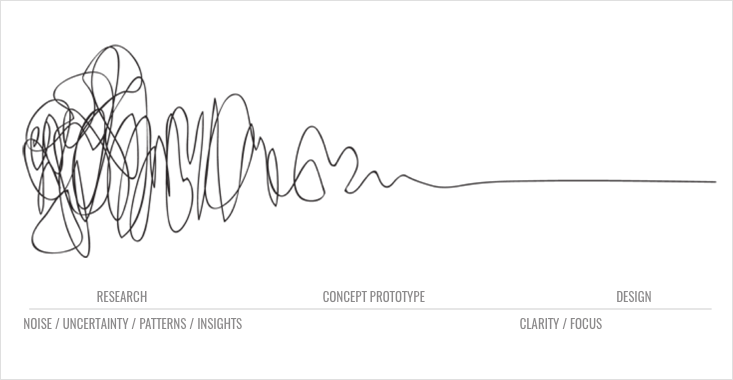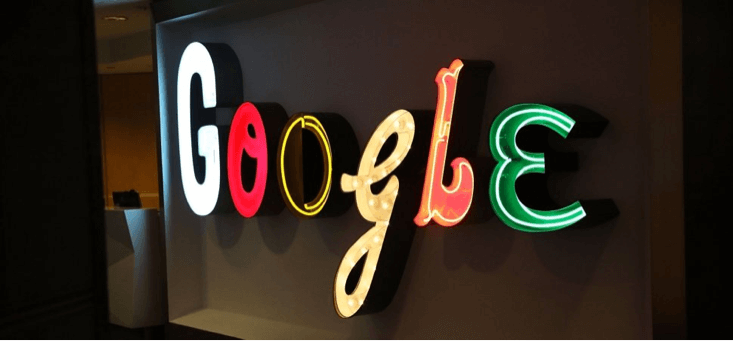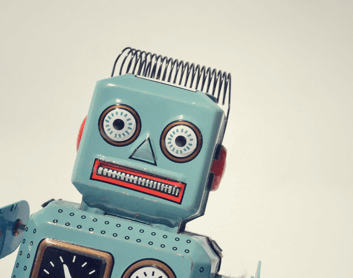
Creativity is messy and usually non-linear
There are many ways to boost creativity and inspire innovation. But the truth is that creativity is unpredictable, can’t always be summoned on command, and usually involves exploring a number of wrong paths before the right one is found. This makes it tricky to plan for the creative process when building digital products. Experience, an open mind, and resilience are critical to ensure success.
Several years ago, Apple made a video, “Intention,” that has become iconic. Created to accompany the launch of a suite of new products, this animated short was intended to distinguish Apple from its competitors, who they inferred were too busy “building everything” to ever really perfect one thing.
My favorite moment in this piece is the line “for every yes there are a thousand no’s.” Each time I show this video during an ideation workshop, I’m reminded that this philosophy is part of the reason that Apple is synonymous with good design. Their products focus on simplicity, intentionally void of extraneous features and functionality that take away from the core experience. And likely, it took a few tries to get there.
How does it look in reality?
During the early stages of any project, the unknowns can feel daunting. This is especially true in a new domain, where often it’s necessary to get up to speed on vast amounts of research, in order to gain credibility during design and ensure you’re not senselessly repeating work that’s already been done. Rapid immersion to uncover insights is not usually a tidy, linear process and information is coming from every direction. Synthesizing inputs, identifying needs and behaviors, and benchmarking the competition in order to ultimately define requirements does get easier with experience, but it’s never a cakewalk. One of my favorite illustrations is this one, that emphasizes how the design process looks in reality.
 Source: The Process of Design Squiggle by Damien Newman, thedesignsquiggle.com
Source: The Process of Design Squiggle by Damien Newman, thedesignsquiggle.com
One of the most challenging scenarios is the request to “design something I’ve never seen before.” (And yes, I promise I’ve been asked to do this more than once!) How do you estimate the time it will take for this kind of creativity, which inherently will involve many dead-ends before the novel solution is realized? How long will it take to come up with a truly signature moment? The answer to each of these questions is, of course, “it depends.” A creative breakthrough can happen at any time, propelling you towards the best solution, but it’s important to recognize that there will typically be “waste” along the way that must be created and then discarded. And that’s ok. That’s why sketching first and holding off on pixel perfection is crucial, as it ensures you’re focusing on concepts and structure, and saving the visual polishing for later.
Tolerance for failure
I just had a curriculum accepted to teach a course at the undergraduate level on “Design Thinking & Product Innovation.” I’ve heard from friends and colleagues teaching at this level that many students today are so focused on excelling and achieving that they are reluctant to take the kinds of risks that can lead to creative breakthroughs. One of the things that I hope the students in my course will get a better understanding of is that failure is an inherent part of the innovation process. This course is designed to promote this construct, rewarding students who take risks and learn from their mistakes.

If you have no tolerance for failure, you will not create anything new
 Getty Images
Getty Images
Google is a company that has embraced this principle so deeply within its culture that employees are rewarded for “failed projects” with bonuses and extra vacation days. This may seem like a strange phenomenon, but as Astro Teller, head of X (formerly Google X) describes in his TED talk, it’s essential if you want people to feel comfortable working on big, risky projects and exploring bold ideas. The “Moonshot Factory” is a place that encourages multidisciplinary collaboration, hoping that this cross-pollination will seed the most exciting ideas. To ensure that compelling ideas don’t die prematurely on the vine, projects are incubated and assessed continuously to confirm their potential to move forward.
There are a variety of reasons that a project can get canceled, including how much it will cost to create an initial prototype. Because tight feedback loops, constant learning and iterative design are inherent parts of X’s structure, a prototype that costs over $200 million dollars as was the case in one project, is just too expensive. Discovering a major flaw in a project doesn’t always mean that it is ended, however. In some cases, it triggers an important shift in perspective and pushes the team onto a more productive path towards a solution.

The moonshot factory is a messy place. But rather than avoid the mess, and pretend it’s not there, we’ve tried to make that our strength. We spend most of the time breaking things and trying to prove that we’re wrong
Harnessing adversity
Failure is also key to building resilience. Although it never feels fun to fail at something, taking the time to reflect and identify why something went wrong is essential. Using a structure during a project retrospective that begins by asking “What went well?” before asking “What didn’t go well?” forces teams to initially focus on the positive - and writing it down ensures there is a written record that can be referenced in future. Intentionally removing blame, and providing “psychological safety” promotes trust and helps ensure team members will escalate issues without fear.
Volkswagen recently launched a new video designed to move the company beyond the diesel engine scandal that has weighed it down for the last four years. The video depicts a lone designer working and reworking an idea to final, brilliant resolution, and ends with the words “In the darkness we found light. Introducing a new era of electric driving.” The iconic Simon & Garfunkel song “Sounds of Silence” plays in the background, as VW cleverly portrays a vision for the future of driving - and the VW brand - that is both human and hopeful.
This poetic piece speaks to the resilience of a company that created vehicles which became icons of a generation, but has since fallen from grace. VW is presenting a vision for a new fleet of beautifully designed, all-electric vehicles. I personally hope that the generation growing up now, Gen Z, will feel similarly inspired to be creatively bold, appropriately risk-taking, and passionately committed to taking better care of the earth.


